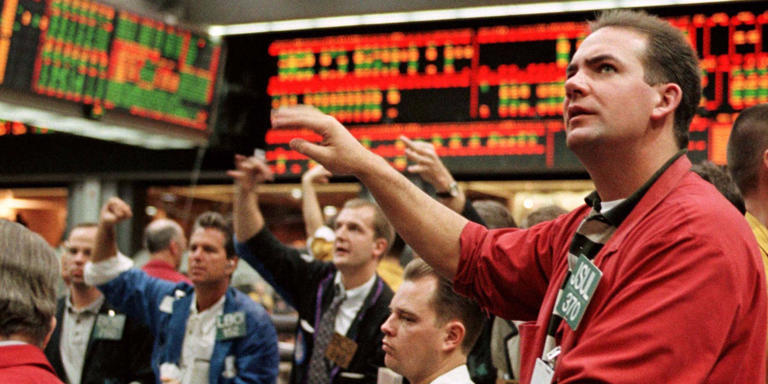Key Takeaways:
- Ed Yardeni, president of Yardeni Research, predicts continued stock market growth for the rest of the decade.
- He draws parallels between the current market conditions and the booming stock market of the 1990s.
- Yardeni attributes this positive outlook to the alignment of interest rates with inflation expectations.
- He emphasizes that interest rates are likely adequately adjusted for inflation, similar to the conditions seen during the “roaring 1990s.”
- This alignment suggests that the current market environment is conducive to further stock market growth.
- Interest rates play a crucial role in shaping investor sentiment and market dynamics, supporting Yardeni’s bullish stance on stocks.
Ed Yardeni, president of Yardeni Research, believes that stocks are poised to continue their upward trajectory over the next decade. He draws parallels between the current market conditions and the “roaring 1990s,” a period characterized by a remarkable rally in stock prices. Despite concerns from some commentators about a potential price correction due to high interest rates, Yardeni remains optimistic about the market’s outlook.
Yardeni points to the recent strong performance of the S&P 500 and suggests that the US economy may be on the brink of another period of rapid growth, reminiscent of the “roaring ’20s.” He acknowledges that some analysts have warned of a looming price correction, but he believes that the current market environment resembles that of the late 1990s when interest rates were favorable, and the stock market experienced significant gains.
In his analysis, Yardeni emphasizes the positive impact of rising stock prices on economic growth. He suggests that during the late 1990s, the surge in stock prices contributed to robust economic expansion. Furthermore, he notes that inflation remained subdued during this period, largely due to rapid productivity growth.
Yardeni’s optimistic outlook is supported by his assessment of the federal funds rate (FFR) trajectory. He suggests that interest rates in the coming years may follow a similar path to that of the late 1990s, further bolstering his confidence in the continued growth of the stock market.
During the late 1990s, interest rates were indeed raised to the 4%-to-5% range as a measure to address inflationary pressures. However, this tightening of monetary policy was likely aligned with the neutral interest rate, which is a theoretical level that neither stimulates nor restricts economic growth. As a result, the economy experienced a robust period of expansion characterized by strong growth indicators.
Productivity, a key driver of economic output, reached its peak at around 4% by the end of the decade. This surge in productivity contributed to the overall growth of the economy and fueled optimism among investors. Additionally, both unemployment and inflation saw significant declines during this period.
The unemployment rate dropped to approximately 4%, reflecting a tight labor market and robust job creation. Meanwhile, consumer prices, a measure of inflation, fell to 2.7% in the late 1990s. This combination of low unemployment and subdued inflation created a favorable economic environment that supported the sustained growth of the stock market.
In the latter half of the 1990s, the stock market experienced remarkable growth, with the S&P 500 index surging by a staggering 220% from 1995 to the close of 1999. This substantial increase saw the index rise from 459 to 1,469, reflecting a period of exceptional performance for equities.
Ed Yardeni, in drawing parallels to the present day, suggests that this historical performance could serve as a blueprint for the remainder of the current decade. He speculates that if this scenario unfolds, it may coincide with a sustained elevation of the federal funds rate (FFR), the benchmark interest rate set by the Federal Reserve.
Currently, central bankers have raised the federal funds rate to a range of 5.25% to 5.5% in an effort to combat inflation, marking the highest level since 2001. However, Yardeni highlights that when adjusting for inflation, the real federal funds rate stands at approximately 2.24%. This suggests that despite the nominal rate being elevated, the real rate remains within a range that historically has not posed significant challenges to economic growth.
During the latter half of the 1990s, real interest rates fluctuated between 2% and 4% without adverse consequences, indicating that the United States could potentially achieve a soft landing in its economic trajectory. Yardeni anticipates that real interest rates will act as a constraint on inflationary pressures, even amid projections of increasing productivity and gross domestic product (GDP) growth.
He forecasts that productivity rates may rise to a range of 3.5% to 4.5% by the end of the 2020s, while real GDP growth is expected to hover around 3.1%, aligning with its historical average. These projections suggest a positive outlook for economic performance over the coming decade, mirroring the dynamics witnessed during the prosperous late 1990s.
Ed Yardeni’s analogy prompts the question: Are we currently experiencing a period akin to the early or late 1990s? Yardeni acknowledges uncertainty regarding this comparison but emphasizes the positive impact of the stock market’s record highs on the economy, drawing parallels to the significant wealth effect observed during the latter half of the 1990s.
The current buoyancy of the stock market indexes, reaching unprecedented levels, is contributing to a positive wealth effect, which, in turn, bolsters economic resilience. This factor, among others, may lead the Federal Reserve to exercise caution in lowering the federal funds rate (FFR) in the near term, potentially prolonging the period before any rate adjustments.
Despite investors’ expectations of rate cuts in 2024, Fed officials have indicated a possibility of maintaining higher rates for an extended period, particularly in response to ongoing inflationary pressures. Market projections, however, continue to anticipate rate cuts, with a significant portion pricing in the potential for substantial reductions by the end of the year, surpassing the Fed’s official projections. According to the CME FedWatch tool, there is a 43% probability of the Fed implementing interest rate cuts of 100 basis points or more by year-end, exceeding the Fed’s forecasted 75 basis points for the year.
